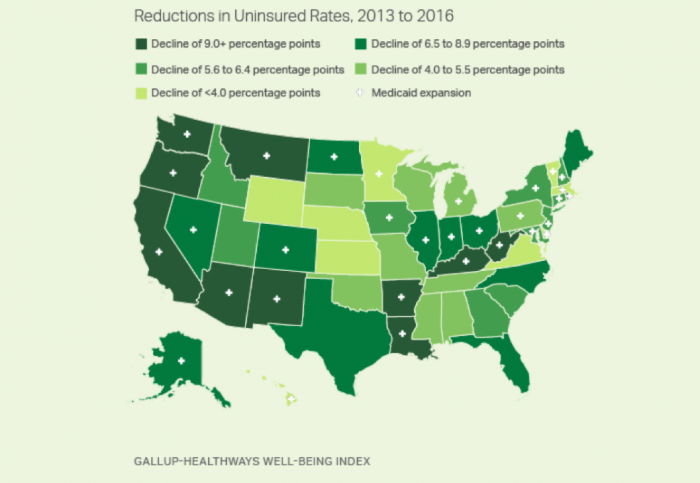Affordable Care Act Cuts Uninsured Rate by 6.4% Since 2013
Six states saw their uninsured rate drop by double-digits since 2013, according to a recent Gallup-Healthways study.

Source: Thinkstock
- From 2013 to the end of 2016, the percentage of individuals without health insurance dropped across the nation, according to a recent Gallup-Healthways study.
The national percentage of those without health insurance went from 17.3 percent in 2013 to 10.9 percent in the fourth quarter of 2016.
All 10 states with the greatest reductions in their uninsured rates had expanded Medicaid as part of their implementation of the Affordable Care Act. In contrast, the study found that states who declined the Medicaid expansion were less likely to see their uninsured rates decrease.
Among the top 10 states that made the most progress with bringing health insurance to their residents, six of them witnessed double-digit drops.
Kentucky and Arkansas led the pack with the largest decrease in uninsured residents, with both seeing reductions in excess of 12 percent. The top ten are rounded out (in order) by: West Virginia, New Mexico, California, Oregon, Washington, Arizona, Louisiana and Montana.
Kentucky, which ranks as the 44th healthiest state in the US, has been a national success story in the expansion of coverage to lower income populations.
In 2013, Kentucky had a 40.2 percent uninsured rate for those within 125 percent of federal poverty limits. Due in large part to Kynect, the state’s expanded health insurance marketplace, that number is down to 23.6 percent. In 2016, nearly one-third of Kentucky’s population received healthcare through an ACA Medicaid expansion program.
The survey also found that the 10 states with the biggest reductions in the uninsured were not necessarily the 10 states with the lowest uninsured rates. In 2016, ten states maintained uninsured rates below 7 percent: Hawaii, Massachusetts, Iowa, Minnesota, Vermont, West Virginia, Wisconsin, Connecticut, Pennsylvania and North Dakota.
West Virginia, third on the sharpest decline list, was the only state to make it onto both lists, with 6.1 percent uninsured by the end of 2016.

Source: Gallup-Healthways
Massachusetts lead the nation with the lowest uninsured rate at 3.2 percent. The state was the first in the nation to mandate health coverage for its residents beginning in 2008. 2016 was the ninth year in a row the Bay State had taken the number one spot, although it was joined by Hawaii with 3.2 percent in 2016.
The highest uninsured rates were concentrated in the Southern and Southwestern states. Texas led the pack with 20.5 percent uninsured, although that figure represents a 6.5 percent reduction in the uninsured resident rate from 2013.
The study found that as of July 2016, the 31 states which did expand Medicaid have experienced the largest reductions of uninsured.
Among the 11 states with the smallest reductions of uninsured people, six had not expanded Medicaid with adoption of the ACA. Those states include Kansas, Nebraska, Virginia, Wyoming, Alabama and South Dakota. At a 0.2 percent decrease, Kansas led the US with the smallest reduction of uninsured residents.
The remaining five states, (Massachusetts, Hawaii, Vermont, Delaware and Minnesota) already had the lowest uninsured rates in the country and simply ran out of room to statistically decrease.
Only Kansas and Delaware did not have a reduction in the uninsured rates in that three-year period. None of the states showed an increase in the uninsured rate in 2016 versus 2013.
Data further showed Medicaid expansion states had cut the insured rates nearly in half from 2013 to 2016, from 15.8 percent to 8.2. Non-expansion states cut rates from 20.2 percent to 14.5 during the same period.
The report concludes that despite ACA critics who argue the program has forced some people out of health coverage, the net decrease of uninsured Americans was 15.9 million adults from 2013-2016.
